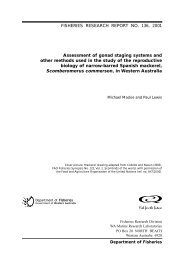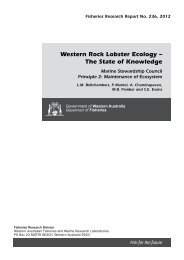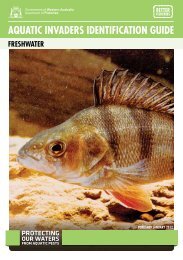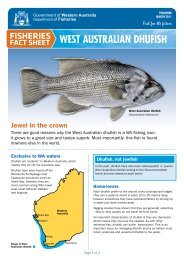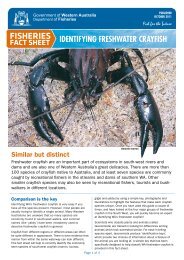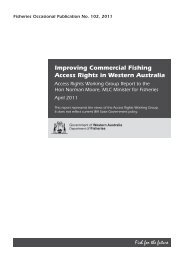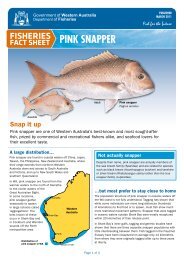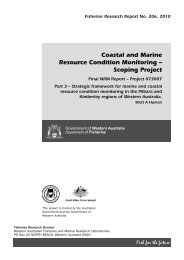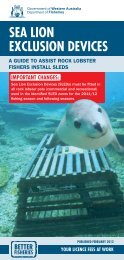DEPARTMENT OF FISHERIES ANNUAL REPORT TO THE ...
DEPARTMENT OF FISHERIES ANNUAL REPORT TO THE ...
DEPARTMENT OF FISHERIES ANNUAL REPORT TO THE ...
Create successful ePaper yourself
Turn your PDF publications into a flip-book with our unique Google optimized e-Paper software.
OvERvIEw <strong>OF</strong> AgENCy � PR<strong>OF</strong>ILE <strong>OF</strong> <strong>THE</strong> <strong>DEPARTMENT</strong> <strong>OF</strong> <strong>FISHERIES</strong><br />
Profile of the Department of Fisheries<br />
vision: World-class management of fisheries and<br />
aquatic ecosystems.<br />
mission: to conserve, sustainably develop and<br />
share the use of the State’s aquatic resources and<br />
their ecosystems for the benefit of present and<br />
future generations.<br />
our message to the community: Fish for the future.<br />
The Department of Fisheries manages the marine<br />
and freshwater fisheries and ecosystems within<br />
the limits of the State. By agreement with the<br />
Commonwealth, the Department has unique<br />
management responsibilities within Australian<br />
waters out to 200 nautical miles from the Western<br />
Australian coast. This allows for management on a<br />
spatial scale that is appropriate to the sustainable<br />
management and protection of the State’s fish<br />
resources and their environment.<br />
The principles of Ecologically Sustainable<br />
Development, as contained in the objects of the<br />
Fish Resources Management Act 1994, guide<br />
the Department in its operations. These objects<br />
involve managing human impacts on both target<br />
47<br />
and bycatch fish species and their habitats, and<br />
assessing and limiting any potential indirect<br />
impacts of fishing and aquaculture activities on<br />
the broader ecosystem. It also includes managing<br />
social and economic impacts of fishing and<br />
aquaculture activity.<br />
The Department works in the presentday<br />
context of limited fish and environmental<br />
resources, and a growing human ‘footprint’ on<br />
the aquatic environment. Factors with increasing<br />
impact include a growing population, developing<br />
coastal infrastructure, industrial development,<br />
rapidly advancing ‘fish-finding’ technology and<br />
climate change.<br />
As a result of the Department’s activities,<br />
around 80 per cent of WA’s marine waters are<br />
protected through fishing closures or controls on<br />
fishing methods that can impact directly on marine<br />
habitats (for example, trawling) and are totally<br />
closed to highly-destructive fishing methods (for<br />
example, dredging and explosives). The Department<br />
ensures compliance with fishing rules and controls<br />
through an active community education and<br />
enforcement program.



